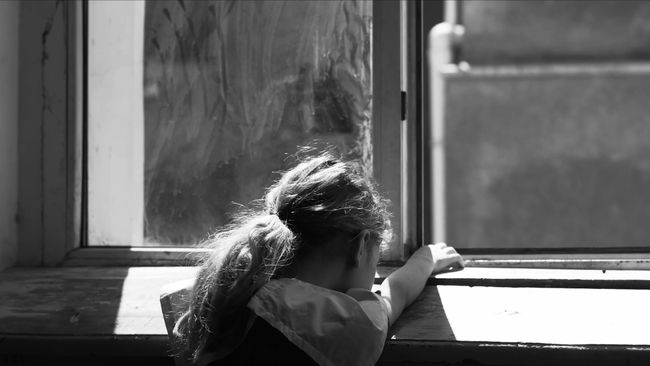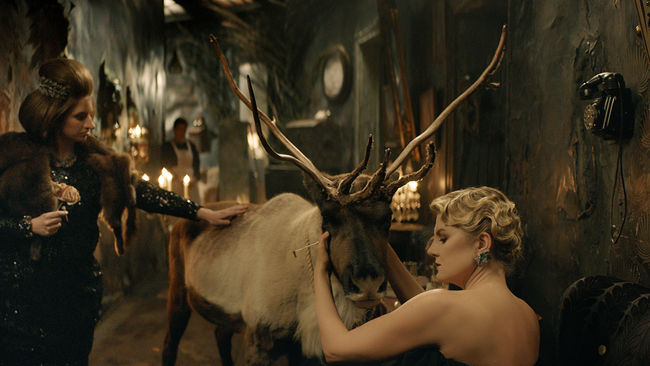Gritt – True Gritt
28 January 2021
For each of the features in competition, IFFR asked a critic, writer, academic or programmer to write a short reflection in a personal capacity. The resulting series of ‘Appreciations’ aims to encourage viewers − and filmmakers − at a time when there is no physical festival. Maria Fosheim Lund shines a light on Gritt.
Born out of Scandinavian feminism but left behind by Scandinavian capitalism comes performance artist and trailblazer Gritt, played by Birgitte Larsen in a tour de force performance. Marching to the beat of her own drum, Gritt has wandered the artistic worlds and underworlds for so long that it is a shock for her to realise that she hasn’t, during all this time, amassed any cultural capital. Let alone any other form of capital.
In her head, she is the director-producer-orchestrator-to-be of a large ritual-cum-performance that will involve a human chain around the Oslo fjord in the piece ‘The White Inflammation’. But her application to the Norwegian Arts Council is coldly declined, due to a lack of formal education and practical competence. This ultimate rejection from the career-making/breaking art bureaucracy sends Gritt on a spin through Oslo’s East Side streets and alternative arenas where ideas and ideals of art, philosophy and politics intersect, and are still valued and considered essential. And it is here, in the area where thoughts and actions matter, that Itonje Søimer Guttormsen presents her truly original work, which combines an indie/low-budget aesthetic with a high-stakes orchestration of dialogue, photography, editing and soundtrack, with herself involved in all aspects of the production.
While her former schoolmates and peers are performing endless variations of Henrik Ibsen’s plays, a kind of art that is easily labelled, marketed and presented at, say, a Norwegian-American culture festival in New York, Gritt envisions a much larger project. A project that carries real urgency. As she sees it, Scandinavian society has been numbed by something like a white fog, an inflammation that renders its citizens apathetic, drugged down by their own comfort: hygge. Gritt seeks an art practice that resonates and makes her audience aware of the wrongs and the pains of the world, art that has the potential to smash both the patriarchy and the echo chamber that belongs to the established art elite − and society at large. Herein lies a sharp critique of the contemporary art scene that seems to have moved away from these once-quintessentially artistic values, and Gritt knows she makes most people deeply uncomfortable when she breathlessly describes her all-encompassing vision.
But still, while Gritt manages to connect somewhat on an artistic level with people on her path, she finds it harder to connect on a human level, which sets the scene for many a disaster for the lonely and unique hero, who has few peers in life or in Scandinavian cinema. Indeed, if we look for similar strong-minded outcasts in Norwegian film history, two very different women spring to mind: Eli Laupstad (Lil Terselius) in Anja Breien’s Forfølgelsen (The Witch Hunt, 1981), persecuted by her fellow villagers in medieval Norway. And the poet Marie Takvam as the ill-at-ease housewife Inger Johansen, who experiences a profound lack of meaning in life in Vibeke Løkkeberg’s debut feature Åpenbaringen (The Revelation, 1977), but refuses to hide her discomfort at home. Just like Breien and Løkkeberg before her, Søimer Guttormsen refuses to pass any judgement on her protagonist, cheering her on at every step. Gritt’s stream-of consciousness-like voice-over, at times quite enigmatic, carries poetic and sharp observations, and the dynamic soundtrack carefully underlines both her moods and actions, leaning beautifully on ‘Lilithoratoriet’, written by Aina Villanger and composed and performed by Hanne Hukkelberg.
Gritt’s spheres are places far away from Scandinavian hygge trademarked by Nordic design, and Gritt’s Oslo is not one of hip coffee bars, pretty parks and architectural landmarks. Itonje Søimer Guttormsen’s eye and care for details in the scenography and urban environments are almost defined by a hyperrealist quality, which presents views of Oslo so heavily suppressed by a current rebranding of the city as a chic and sleek city on the waterfront, that it is almost shocking to see for a local audience. In Gritt, Oslo is a city of underpasses and basements, railways and trash cans, of squatters and immigrants, pigeons, thrift shops and graffiti, all the while beautifully photographed, and presented with a sense of wonderment in a fashion that brings Agnès Varda’s films to mind (Vagabond, The Gleaners and I, for instance). Indeed, like Mona in Vagabond, Gritt is herself homeless, and while one part of her seems to be rationalising it away by explaining to a friend that being a performance artist equals living frugally, she is also wondering about her sanity. As she finds a new project working with a refugee centre and experiences a brief feeling of artistic release and fulfilment, this too ends in frustration and despair, and in the end, she finds no other option than to leave the city.
A little cottage in the woods becomes the place where Gritt can unite her inner thoughts and her physical appearance, which sets the stage for a reborn and stronger Gritt. Strongly influenced by the tale of Lilith in Jewish mythology, Gritt finds in it a mirror image − a woman unattached and free, in control of her creations. Her survival and thrift in the forest for weeks or months gives Gritt renewed energy and perhaps a new arena for her message: YouTube. Venturing back into the world in a refitted outfit − part cowboy, part animal, part warrior − the film ends with surprisingly familiar tropes from the Western genre: Gritt catching a ride into the sunset, head held high. This time the camera welcomes her into the frame, rather than struggling to keep up the pace with her slightly slumped figure as she previously hurried through the streets of Oslo.
Maria Fosheim Lund is a film critic and curator who has written for several publications. She is currently Head of Cinema at the art cinema space Kunstnernes Hus Kino in Oslo.
Appreciations
‘Appreciations’ aims to encourage viewers − and filmmakers − at a time when there is no physical festival. Discover more short reflections on the features in competition.



